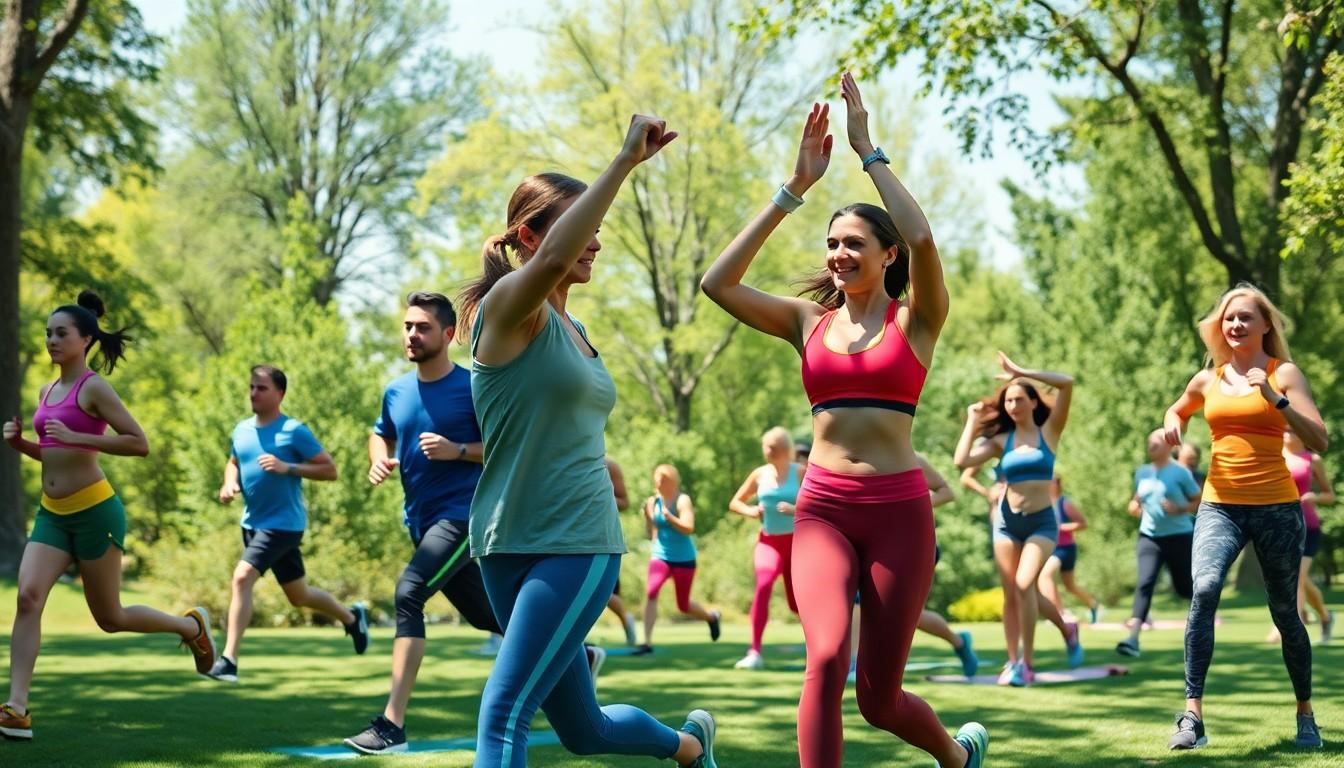When it comes to staying active, many people throw around the terms “physical activity” and “exercise” like confetti at a parade. But wait—are they really the same thing? Spoiler alert: they’re not! Understanding the difference could be the key to unlocking a healthier, happier lifestyle.
Physical activity is any movement that gets the body going—think dancing in the kitchen or chasing the dog around the yard. Exercise, on the other hand, is like the fancy cousin who shows up with a workout routine and a gym membership. It’s structured, purposeful, and often involves a bit of sweat. By grasping these distinctions, readers can tailor their approach to fitness and make the most of their time—whether they’re breaking a sweat or simply breaking out into a spontaneous dance party.
Understanding Physical Activity
Physical activity includes any movement that engages the body. It involves a variety of actions, from walking to household chores, contributing to overall health.
Definition of Physical Activity
Physical activity refers to any movement produced by skeletal muscles that requires energy expenditure. It encompasses routine daily tasks such as walking to a store, gardening, or cleaning. Engaging in these movements increases heart rate and promotes caloric burn, supporting physical health. Unlike structured exercise, physical activity often occurs in casual settings and can be easily incorporated into a daily routine. Recognizing this broad definition of physical activity allows for a more inclusive understanding of ways to stay active.
Types of Physical Activity
Various types of physical activity exist, each offering different benefits. Aerobic activities include walking, running, and cycling, enhancing cardiovascular fitness. Strength training, such as lifting weights or resistance exercises, builds muscle and bone density. Flexibility exercises such as stretching improve range of motion and help prevent injury. Additionally, recreational activities like dancing, swimming, or playing sports provide enjoyable ways to stay active while socializing. By diversifying physical activities, individuals can create a balanced routine that supports overall wellness.
Exploring Exercise

Exercise represents structured physical activity performed for fitness and health benefits. Engaging in exercise often requires planning and consistency.
Definition of Exercise
Exercise involves purposeful movements designed to improve physical fitness. This category of activity focuses on enhancing cardiovascular health, strength, flexibility, and endurance. Common forms of exercise include cardiovascular workouts, resistance training, and stretching routines, each targeting specific fitness components. Consistent participation in exercise programs contributes to improved overall well-being and can reduce the risk of chronic diseases.
Types of Exercise
Exercise can be categorized into four main types: aerobic, strength training, flexibility, and balance.
- Aerobic exercise includes activities like running, swimming, and cycling, which elevate heart rate and improve cardiovascular health.
- Strength training focuses on building muscle through lifting weights or using resistance bands, enhancing muscle tone and strength.
- Flexibility training targets muscle and joint flexibility through stretches and yoga, increasing range of motion and reducing injury risk.
- Balance exercises include tai chi and specific stability drills, promoting coordination and stability, particularly in older adults.
Diverse exercise types promote comprehensive physical health.
Key Differences Between Physical Activity and Exercise
Understanding the distinctions between physical activity and exercise enhances fitness routines. Both concepts contribute uniquely to personal health.
Duration and Intensity
Physical activity varies widely in duration and intensity. Daily movements like walking or gardening often occur over longer periods with low to moderate intensity. In contrast, exercise typically involves shorter bursts of higher intensity, focusing on specific fitness goals. For example, a 30-minute run represents structured exercise, while a leisurely walk may involve longer but less intense activity. Engaging in these activities promotes energy expenditure but does so in different ways. Furthermore, physical activity integrates more easily into busy lifestyles than structured exercise routines.
Purpose and Goals
Different purposes define physical activity and exercise. Physical activity aims to increase overall movement throughout the day, promoting general wellness. It often incorporates enjoyable activities like playing sports or dancing. Exercise, however, focuses on specific fitness improvements such as strength, endurance, or flexibility. Structured workouts often link to personal goals, such as weight loss or muscle gain. An individual participating in an aerobics class works toward cardiovascular health, while someone playing with their dog seeks enjoyment and light activity. Both are essential, but their objectives differ significantly.
Benefits of Physical Activity
Physical activity offers numerous advantages that enhance overall well-being. It contributes to improved physical health and supports mental wellness.
Physical Health Benefits
Regular physical activity strengthens the heart, reducing the risk of cardiovascular diseases. Increased movement also boosts metabolism, aiding in weight management. Muscles and bones benefit from activities like walking, jogging, or dancing, promoting strength and endurance. Engaging in diverse activities enhances flexibility and balance, decreasing the likelihood of falls among older adults. Enhanced immune function links closely to consistent physical movement, resulting in fewer illnesses.
Mental Health Benefits
Physical activity significantly improves mental health by reducing symptoms of anxiety and depression. Engaging in regular movement releases endorphins, often termed “feel-good” hormones, which elevate mood. Social interactions occur during group activities, providing emotional support and reducing feelings of isolation. Furthermore, routine physical activity enhances cognitive function, aiding memory and concentration. Establishing a consistent movement routine also fosters a sense of achievement and boosts self-esteem.
Benefits of Exercise
Exercise contributes significantly to overall health and fitness. This section delves into the specific physical and mental health benefits associated with regular exercise.
Physical Health Benefits
Regular exercise strengthens the heart and improves cardiovascular health, reducing the risk of heart disease. Muscles and bones benefit from resistance training, which enhances strength and density. Weight management becomes easier as exercise boosts metabolism, aiding in calorie burn. Flexibility and balance improve with consistent stretching routines, helping prevent injuries. Individuals may also experience better sleep quality and increased energy levels. Overall, structured exercise plays a crucial role in enhancing life quality by promoting better physical functioning and resilience.
Mental Health Benefits
Exercise serves as a powerful mood booster. Endorphins released during workouts can alleviate symptoms of anxiety and depression. Regular physical activity fosters social connections through group classes or team sports, helping combat feelings of isolation. Cognitive functions, including memory and concentration, often improve with consistent exercise routines. Establishing a workout habit can also enhance self-esteem and a sense of accomplishment, contributing to overall mental well-being. Regular movement creates a more positive outlook on life, making it easier for individuals to manage stress effectively.
Conclusion
Understanding the difference between physical activity and exercise is essential for anyone looking to enhance their health and well-being. While physical activity includes any movement that gets the body moving, exercise is a more structured approach aimed at achieving specific fitness goals. Both play vital roles in promoting overall health.
Incorporating a mix of both into daily routines can lead to better physical and mental health outcomes. By recognizing the unique benefits of each, individuals can tailor their activities to fit their lifestyle and preferences. This balanced approach not only fosters a healthier body but also supports a more fulfilling life.

